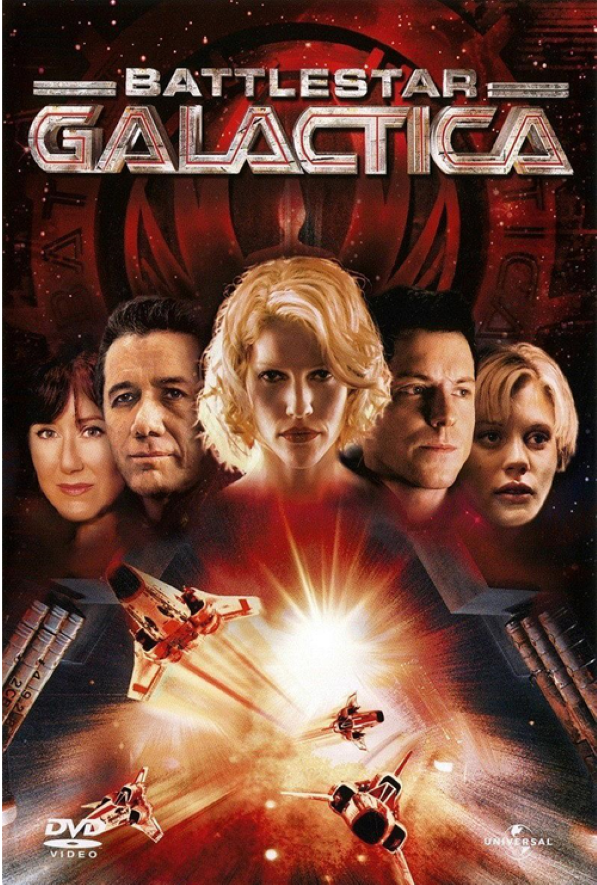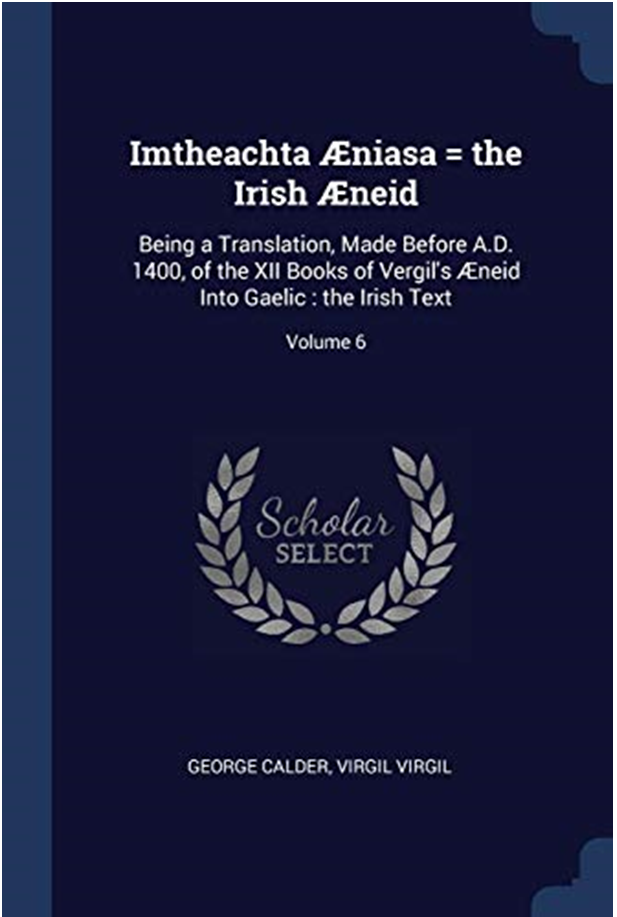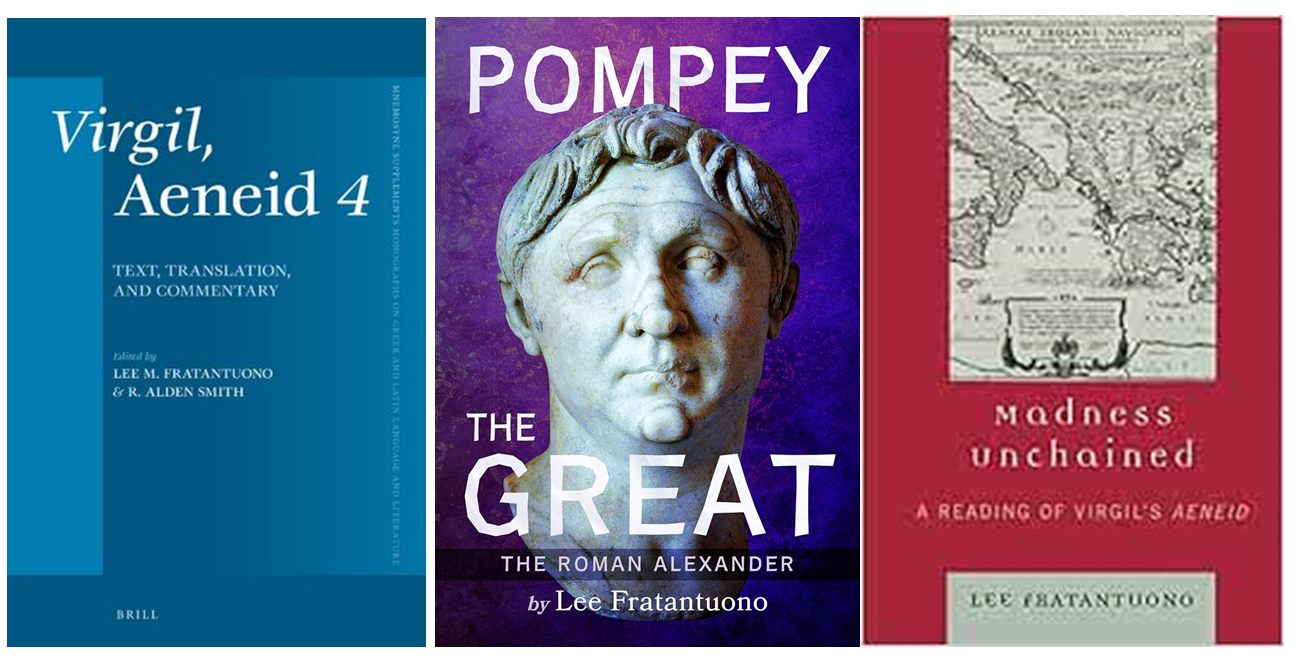Lee Fratantuono delves into the Imtheacta Aeniasa
For a decade now, my scholarly research has centered on contributing commentaries to co-edited volumes devoted to individual books of Virgil’s Aeneid for Brill (now De Gruyter Brill). Books 4, 5, and 8 have appeared in collaboration with Alden Smith, and Book 1 is in an advanced stage of completion, with Angeliki Roumpou. Along the way, I have undertaken a number of smaller-scale Virgilian projects, both in textual criticism and in the study of both familiar and more neglected sources for the Aeneid (notably Callimachus as well as Pindar, Aristophanes, and the fragmentary Greek lyric and elegiac poets). I have also continued my ongoing, long series of individual studies of Virgilian characters (both major and minor) Collaborations have been fruitful in these areas as well, with forthcoming work on Virgil’s debts to Philodemus and Parthenius (with Michael McOsker), and on Virgil’s Circe (with Olivia Peukert Stock).
Virgilian studies infuse other classical projects. Late in 2024, two additional books of mine will be released: A Reading of Propertius’ Elegies and Pompey the Great: The Roman Alexander. Propertius invites ready comparison to Virgil, and in many regards his fourth (or fifth?) book can justly be called an elegiac Aeneid. Spending considerable time researching Pompey’s life (especially his conflict with Caesar) elicits more nuanced readings of Virgil’s musings on heroism, and on his references to Caesar and his storied republican rival.
In 2025, however, much of my time will be devoted to a very different sort of book. A Companion to the Original Battlestar Galactica will look at the landmark 1978-1979 television science fiction series. But here, too, Virgil claims his rightful place. Battlestar Galactica boasts an impressively devised mythology that is deeply indebted to the Aeneid, not just on the basic level of its relating the story of an exiled people seeking a new home after a long war, but on the more detail-oriented front of creating characters modeled in no small part on Virgil’s depiction of classical deities and heroes. From Maren Jensen’s Athena to Richard Hatch’s Apollo, Battlestar Galactica makes its own contribution to the Virgilian afterlife.
For the Virgilian, Nachleben is as priceless as Vorleben. In graduate studies, I was first introduced to the the rich tradition of mediaeval translations of the Aeneid, with close study in particular of the Old French Roman d’Énéas. “Translation” is a misnomer for these mediaeval vernacular works. The composers of these sprawling, dazzling monuments of the Virgilian translation were more than willing to expand on favourite episodes while shortening others, to provide virtual quasi-commentary on the original text, and along the way to offer rich insights into the cultures and circumstances that shaped their productions. Early in my career I benefited from time at the University of Dallas, where my colleague Stephen Maddux was trained in Old French; thanks to work with him, I was able to acquire a reading knowledge that permitted direct engagement with the mediaeval French Aeneid and related texts.
After becoming affiliated with the Department of Ancient Classics at Maynooth, a priority for me was to make an intensive effort to tackle Old and Middle Irish in the same way, so as to delve into a tantalizing work that thus far I had studied only cursorily (and in translation): the Imtheacta Aeneiasa or Middle Irish Aeneid. Luckily for me, the younger brother of my college mentor Blaise Nagy is a Celtic Studies scholar, and Joseph Nagy generously recommended exactly how to become immersed profitably in Irish language studies. Eagerly (indeed, voraciously) I was soon buried in paradigms and grammar lessons, all with a focused goal: to approach the mediaeval Irish Aeneid on a serious level of engagement.
The Imtheacta Aeniasa stands out in the vernacular Aeneid tradition. It displays remarkable fidelity to the Virgilian original, which makes its alterations, additions, deletions and re-orderings all the more fascinating. The work invites consideration of the state of the text of the Aeneid in its composer’s day. This is especially true with regard to the very start of the work, which offers noteworthy divergence from the familiar in medias res opening of Virgil’s poem. There are implications here for the question of the process of the composition of the Aeneid and the original order of its books, of familiar analytical questions about evidence for alleged inconsistencies and posthumous editing, questions that we should not hastily dismiss as being unknown or of no interest to the mediaeval author. The more one studies the mediaeval Aeneid tradition, the more one appreciates the value of the (usually anonymous) figures who provided what amount to de facto commentaries on the text that was being rendered into European vernaculars. These authors were deeply imbued both in Latin and the classical tradition, to a degree nearly impossible to replicate today; what they produced is invaluable for Virgilian readers today.
George Calder’s 1903 version of the Imtheachta Aeniasa
Much of the work done on the Imtheacta Aeniasa and its analogues has focused on the necessities of text and translation. There has also been some attempt to consider these works in their historical and literary contexts. Less work has been done on how something like the Middle Irish Aeneid can be valuable for better understanding both of what Virgil said and why he said it. Both textual criticism and literary commentary are appreciably enriched by close study of such twelfth-century (or slightly earlier) masterpieces. While the text of the Aeneid is markedly more stable than that of many other popular ancient authors, a number of passages merit close attention. Paradoxically, the very popularity of the Aeneid has meant that some readings that on close examination are arguably problematic have remain relatively unstudied because they are overly familiar. Here, it is invaluable to have ready access to a learned mediaeval Irish reader’s interpretation of a passage, especially given the noteworthy efforts made by the author of the Imtheacta Aeniasa to be as literal as possible (this is true in particular of his descriptions of nature in particular, of storms and celestial references).
My current project with the Middle Irish Aeneid is focused first on assembling a collection of interesting passages where the Irish text provides helpful hints for a better understanding both of Virgil’s text and its interpretation. Ultimately, the goal is to produce a complete commentary on the Imtheacta Aeneiasa, one that will address its connections both to Virgil and to the mediaeval Aeneid tradition, as well as how the author manages deftly both to be scrupulously faithful to his source material, even as he explores the question of heroism in an Irish context, and as he embarks on nothing less than a quest to make his Aeneid a defining work in solidifying the burgeoning tradition of a national literature. The author of the Imtheacta Aeniasa made the Aeneid Irish, and not merely on the level of rendering Virgil’s Latin hexameters into majestic prose. While preserving fidelity to the Augustan poet (indeed, to a degree unique in the tradition of mediaeval Aeneid renderings), the Irish author endows his translation with qualities reminiscent of those commonly found in national epics. To this end, it is of particular interest to study it in tandem with other storied classics of Old and Middle Irish.
The Aeneid (like the Homeric, Alexandrian, and Roman Republican epics that inspired it) is tissue-like. Every verse is suffused with an astonishing palette of debts to earlier literary monuments; throughout, there is also serious (and still largely understudied) engagement with the artistic challenges posed by the formidable archaeological monuments of the Augustan Age in particular. In the centuries since its publication in the wake of the death of its author, Virgil’s epic of the process by which we move from Troy to Rome (with a trajectory whose implications would not necessarily be entirely palatable to Troy’s most ardent divine patrons) has inspired a vast array of responses in a variety of genres. The Imtheacta Aeniasa deserves to be ranked among the most consequential and impressive achievements of that epic afterlife. More than a mere translation, its prose stands forth as one of the great monuments of the literary arts in that competitive, daunting twelfth-century arena of vernacular hommages to yesteryear. And in the history of Irish literature, its pages offer a window into a consequential period, and into the influence of a timeless tale of travel, heroism, and the hazards thereof on the artistic achievements of an island that was poised at a transformative moment in its history. All those interested in what Virgil said and why he said it in the manner he chose will profit from dipping into the Irish Aeneid (the Irish Texts Society edition, especially the 1995 reprint with the superlative new introduction by Erich Poppe, is essential). Along the way, their knowledge and understanding of Virgil will be enhanced, as will their appreciation for the way in which classical mythology and heroic epic were reimagined in a tour de force tribute to the historical and legendary traditions of Ireland.
Lee Fratantuono is Adjunct Professor in the Department of Ancient Classics, The National University of Ireland-Maynooth ([email protected]). He has published many articles and books on Latin Literature and Virgil in particular: with R. Alden Smith he has published full editions of Aeneid 4 (Brill 2022), Aeneid 8 (Brill 2018) Aeneid 5 (Brill 2015), and in 2007 he published his major study Madness Unchained: A Reading of Virgil's Aeneid (Lexington Books).
DISCLAIMER: the views expressed in these articles are solely those of the author(s) and do not necessarily reflect the views of Classics for All.



